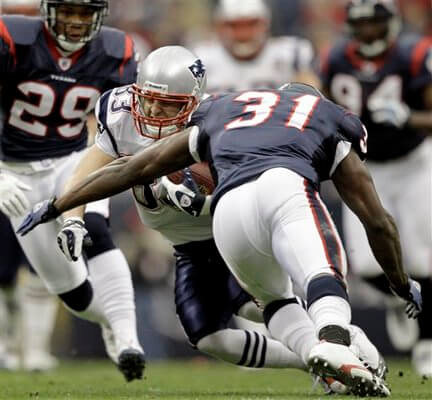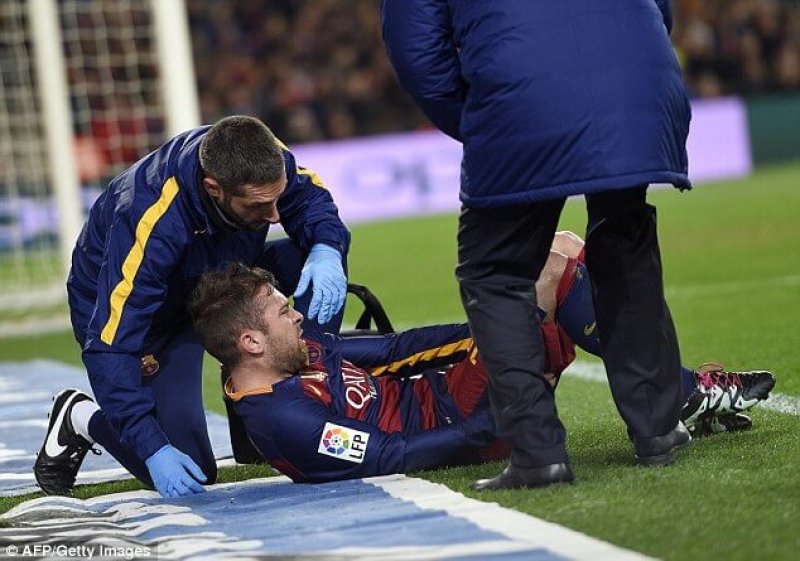“It is very sci-fi.”
That’s how Swedish doctor Matilda Lundblad described the medical treatment for players of Barcelona Football Club, one of the premiere sports teams in the world. In particular, Dr. Lundblad, who collaborates with the team’s medical staff, was talking about the club’s cutting edge utilization of genetics to help manage player injuries and fitness, this according to a recent report in the Daily Mail.
The club’s head physician, Dr. Ricard Pruna who holds a MD and a PhD in genetics from the University of Barcelona, is said to use several markers to identify players whose genes predispose them to injuries or to having a longer recovery period.
Daily Mail and several other news outlets praised the club, which has been one of the most successful sports clubs in the world for many years, for their innovative approach to player care. Sports site Bleacher Report described Barcelona FC as a “pioneer” in sports medicine and claimed their season thus far speaks to the efficacy of their DNA based medical system:
If the testing is indeed in place, it seems to be working at the moment. As noted in the piece, Barcelona currently [on February 21] only had one senior player—midfielder Rafinha—out injured despite having gone through a grueling campaign; they’ve played 42 games to this point.
Is this use of DNA more hype than science?
So far, the Barcelona experiment is supported mostly by anecdotal evidence. That’s convinced Pruna, who has published several studies on the topic of genetics and sports injuries, and the Barcelona organization. Other teams are understandably intrigued. But before these methods become any more widespread in the sports world, it might be helpful to ask a basic science question: not does this system work, but could it work?
Barcelona FC is not the first European squad to integrate information from a player’s personal genetics into their medical treatment. In 2011, the Daily Mail reported that an unnamed English squad (thought to be Liverpool Football Club) was preforming similar tests. According to Yale University School of Medicine genetics professor Marios Kambouris, this unnamed club sent him samples from players to analyze, he explained:
I have no idea which players they were but there were good genes in there, things which would positively affect their performance, such as their ability to have better aerobic respiration, which would give them more stamina on the pitch.
Just before the last World Cup in 2014, two players, English defender Glenn Johnson (then with Liverpool) and Costa Rican midfielder Bryan Ruiz announced they had undergone personal DNA tests offered by British company DNAfit. Johnson believed it gave him a performance edge: “to have this data to show me the best ways to train and to eat so I can be at the top of my game is a remarkable advance.”
Science skeptics
But can genetic information really help players and teams with injury management? Most scientists are highly skeptical. Take a look, for instance, at Dr. Pruna’s publications. One important distinction to make is that ‘genes’ is not really what Pruna and others are looking at, they are looking at alleles—versions of genes—of genes that code for proteins involved with structural molecules like collagen, (an important part of tendons and ligaments) and growth hormones—which are important when the body is healing. The idea is that some people have versions of these genes that change their susceptibility to injuries or improve/decrease their ability to recover from an injury.
So the thinking of Pruna and others goes like this: collagen is a vital component of ligaments (a type of connective tissue that connects bones together); if an athlete has a version of a collagen gene (there are actually several collagen genes) that could lead to a structurally weaker version of collagen, the ligaments that contain this weaker version may be more susceptible to rupture or tear during an athletic event. Or a player could have a version of a growth hormone that speeds up the repair process.
Here is the caveat though. We are only talking about probabilities here. Just because a person has a gene or genes that are linked to a specific condition doesn’t mean that athlete actually will have that condition. That’s because there are many confounding factors including gene-gene interactions and environmental factors that influence whether a possibility becomes a reality. All genes can tell you are probabilities, not certainties. That’s why critics of using genes to predict or monitor medical conditions describe this process as more like astrology than science.

Of course teams and players would love to be able to identify who on their team has genes that would predispose them to having a longer or shorter recovery time. In American football, where anterior cruciate ligament (ACL) injuries have reached epidemic proportions, average recovery time for an ACL injury is just over a year. But some players, like former New England Patriots wide receiver Wes Welker, have been able to recover much quicker. Welker famously was able to do it in under 9 months. Does Welker have any of the alleles that Puna has identified as leading to a quicker recovery from injuries?
While the Daily Mail report does not identify any of the genes that Barcelona is using to evaluate players, Pruna has published a couple of studies on his genetic analyses of Barceonla players. However, his papers suffer from a lack of robust data. Both of his studies listed in PubMed have sample sizes of just 73 and are backed by very weak statistical associations (i.e. p values close to 0.05 which is considered the scientific standard for statistical significance). Yet most of the the alleles he was looking at had no correlation with any of the important parameters like injury susceptibility, severity or muscle injury recovery time. And when he did find an association, they were anything but strong correlations. For example, he found that players carrying versions of a gene that codes for a structural protein called elastin (helps maintain elasticity) had a statistically significant improved ligament injury recovery time. However, because the sample size was so small, and the correlations were so weak, just a couple more data points could push the data to the point where the statistical association is gone (i.e. p value greater than 0.05).
Future of genetics in sports injuries
While Pruna’s work is exciting and part of the larger personalized medicine revolution that is currently occurring in science and medicine, it’s critical to understand how rudimentary this area of science remains. Knowing that one has a potential proclivity for a certain condition does not mean that person will develop that condition. Except in rare instances—cases in which genes lead to certain conditions, such as breast cancer mutations leading to an 80% change of contracting the disease, individual genes generally only indicate proclivities, and often the probabilities, while identifiable, are quite small. That’s the case with the “injury genes” that Puna is studying; the data he collects could be helpful, meaningless or misleading. We just don’t know enough about genes to reach any definitive conclusions.
There is another reality; while genetics may play some part in things like injury recovery time, or injury susceptibility, genes are just one piece of the larger puzzle of how our bodies heal. Wes Welker was 28 years old when he recovered abnormally fast from his ACL tear; most experts doubt he would heal nearly as fast if he tore it again now that he’s 34. That’s because age and previous injury status play a part in injuries too, as does fitness; nutrition and diet. And no gene operate in a vacuum. There is no single “ligament strength gene,” for example. In reality several genes, or dozens, working in synchrony, taking input from environmental cues, influence the strength of muscles, tendons and ligaments. Looking at the probabilities for just one is missing the forest for the trees.
Let’s hope the medical staff at Barcelona knows this and does not rely too heavily on the genetic genetic information they have collected. But they obviously believe it may provide an edge. We live in a big data world, and that is no truer than in the sports world where executives want to ensure a proper return on a multimillion-dollar investment in a player. So they gobble up every data point they can on a player in an attempt to minimize the risks and maximize their values.

Which brings us to Lionel Messi, Barcelona’s star player who is considered the best soccer player on the planet. Could genetics have predicted his success? He was a sensation at six years old. But he was diagnosed with a growth hormone deficiency, a genetic disorder at ten. Yet, nobody would have rejected him because of his genetic disorder. Barcelona signed him to a contract at 13.
Yet, it’s easy to see how genetic information can be misused if its adopted in its current rudimentary form. In college athletics, a test showing a genetic predisposition to injury could lose an athlete a college scholarship. It could result in a star college player getting drafted in a lower round or being ignored altogether. Barcelona and other European soccer clubs start owning players as young as 6 years old; would they reject a 5 year old based on this information?
Parents might be tempted to use this information to keep their kids out of sports or gym class for fear of injuries. In fact, this is already happening with at-home genetic concussion tests, where parents are told (not by physicians) that their child has a predisposition to getting a concussion based on a very weak correlation between concussions and genetics.
So while genetic information in these cases may seem at face value like a good idea, if that information is unreliable—and that’s the situation today—making decisions based of it is foolhardy.
Nicholas Staropoli is the associate director of GLP and director of the Epigenetics Literacy Project. He has an M.A. in biology from DePaul University and a B.S. in biomedical sciences from Marist College. Follow him on twitter @NickfrmBoston.































